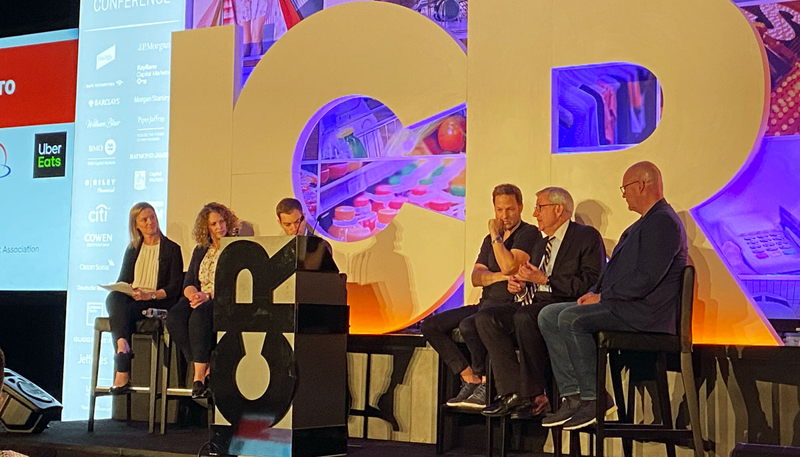Virtual restaurant operation is one of the sexy new things that has restaurants buzzing, but as the virtual restaurant segment grows, there seem to be three dominant paths that take full advantage of the potential for new ways of doing business.
Industry leaders tackled that complex topic at the 2020 ICR conference in a panel titled “The Off-Premises Boom: How restaurants are evolving to answer consumer demand.”
Jim Collins, co-founder and CEO of Kitchen United, said fully virtual operations are complicated things to run, so they no longer allow truly virtual brands inside their shared kitchen facilities.
“What we found is that most of the people that started them don’t know how to run a restaurant,” said Collins. “What we do see in virtual brands that are successful, it’s brands that are extremely focused on very specific dietary requirements or preferences that people are coming to restaurants looking for.”
Hudson Riehle, SVP in the research and knowledge group at the National Restaurant Association, said that resonates exactly with his research on search trends among young restaurant consumers.
“It’s obvious that virtual brands are a part of the future, not just a trend. Millennials will search for menu items, not necessarily for brands. So, the upside for this is that we see pent up demand,” said Riehle.
Of course, there could be unintended consequences, which Olo founder and CEO Noah Glass described.
“I have mixed views of virtual brands good or bad, they’re definitely a thing and they’ll be a bigger thing in the future,” said Glass. “When brands have a core competency and can reformat in a different way, it’s good. But the bad, it’s scary to think about it being much easier to create a competitor that can make things cheaper and better. I think that will have an impact on the industry that a lot of people in this room won’t like.”
He raises a valid concern. In Europe, third-party delivery firms are already spinning out many virtual restaurants to meet the needs of delivery customers. The industry is seeing the same thing in the U.S., but to a smaller degree. CloudKitchens, for one, is looking closely at the data and creating delivery-only virtual restaurants to fill gaps in local offerings.
Nick Kenner, the founder and CEO of healthy and sustainable concept Just Salad, created an entirely virtual brand to cater to special dietary needs called Health Tribes. Also on the panel, he said they created the brand in 2019 in a partnership with Grubhub.
“We started the virtual brand in Q4, Health Tribes. We wanted to make menus for certain dietary lanes,” said Kenner. “But we didn’t want to have a hundred menu items, so we created a virtual brand that is on Grubhub, it has its own entity on Grubhub and in the app.” He said it’s become a nice testing ground where star items “graduate” to the core Just Salad menu.
Of course, the fear is that Grubhub, DoorDash or Uber Eats will build a lot more of these, filling demand and potentially making it harder for traditional or even shared kitchen-based restaurants to compete in the area.
While Uber Eats isn’t operating its own virtual restaurants—yet—it does have key insights around virtual operations. Without naming the companies, Janelle Sallenave, the head of U.S. and Canadian operations at Uber Eats, said data flowing through the system has highlighted three ways her clients are making it work.
“We see three unique ways that virtual restaurants are clicking with consumers,” said Sallenave. “The first is with chain restaurants that see an opportunity, but aren’t sure how to take advantage of it.”
She said one brand had a great burger, but they were known for chicken wings. They were struggling to get delivery volume with their burger, despite burgers and fries being extremely popular on delivery. So, out of the same location, they built a virtual brand to “break into the space.”
“Another variant on that is getting into another daypart. There is a national sandwich chain that we work with, and the volume is more lunch related, they pivoted to a virtual breakfast program,” said Sallenave.
A bakery concept in the system had plenty of breakfast volume, but at noon when the coffee crowd is gone, it flips the script and becomes a burger place on Uber Eats. She said operations like that can see revenue boosts as large as 50 percent by tapping into an entirely new delivery market.
“The third way—and it’s a bit faddy—but it’s how restaurants interact with popular culture. Los Pollo Hermanos, if you know that brand you watched Breaking Bad,” said Sallenave, referring to the fake chicken chain that served as a plot hook in the meth-themed show.
Basin Robbins also created a Stranger Things-themed restaurant on Uber Eats in Australia, and food celebrity Rachel Ray created a virtual pop up around the launch of her new book.
So, the restaurant world is still figuring this out, and given the fractured nature of the industry, there are many, many paths to success in virtual restaurants and potentially a few pitfalls. Whatever happens, as long as order volume increases, virtual restaurants will be a growing opportunity for brands and delivery concepts going forward, it’s just a matter of how operators want to take advantage.


